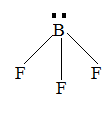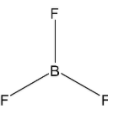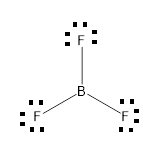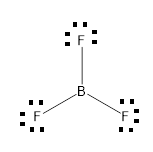
The electron dot structure of $B{{F}_{3}}$ is:
(A)

(B)

(C)

(D)





Answer
556.2k+ views
Hint: The electron dot structure is nothing but the Lewis dot structure. To answer this question we should be aware of the concept of Lewis dot structure. This concept was the basis of VSEPR theory too.
Complete answer:
Lewis dot structure is a representation of the arrangement of electrons around each atom of a compound or a molecule. This is why it is also known as electron dot structure.
Firstly, let's write the number of valence electron in boron and fluorine:
Boron = 5 = $1{{s}^{2}}2{{s}^{2}}2{{p}^{1}}$
Fluoride = 9= $1{{s}^{2}}2{{s}^{2}}2{{p}^{5}}$
The number of valence electrons in B + the number of valence electron in F$\times $3
3 + 7 $\times $ 3
3 + 21
24
The boron is less electronegative than fluorine. So, the boron is the central atom.
Now let's draw the $B{{F}_{3}}$
The boron has three valence electrons and the fluorine will have seven valence electrons around it.

Then, join the electron and make bonds.

From the above drawn diagram, we can say that either option B or option D is the correct answer. The option B is just the structure of $B{{F}_{3}}$ but not the dot structure of $B{{F}_{3}}$. According to electron dot structure the arrangement of electrons around each atom of a compound or a molecule should be shown.
Thus, the Option D is the correct answer.
Note:
The number of valence shells in boron is so there no chance of having lone pairs on boron therefore, option A and C is the wrong answer. Option B is not the dot structure, it is the structure of $B{{F}_{3}}$. Lewis dot structure too has many limitations but certain limitations are overcome by VSEPR theory.
Complete answer:
Lewis dot structure is a representation of the arrangement of electrons around each atom of a compound or a molecule. This is why it is also known as electron dot structure.
Firstly, let's write the number of valence electron in boron and fluorine:
Boron = 5 = $1{{s}^{2}}2{{s}^{2}}2{{p}^{1}}$
Fluoride = 9= $1{{s}^{2}}2{{s}^{2}}2{{p}^{5}}$
The number of valence electrons in B + the number of valence electron in F$\times $3
3 + 7 $\times $ 3
3 + 21
24
The boron is less electronegative than fluorine. So, the boron is the central atom.
Now let's draw the $B{{F}_{3}}$
The boron has three valence electrons and the fluorine will have seven valence electrons around it.

Then, join the electron and make bonds.

From the above drawn diagram, we can say that either option B or option D is the correct answer. The option B is just the structure of $B{{F}_{3}}$ but not the dot structure of $B{{F}_{3}}$. According to electron dot structure the arrangement of electrons around each atom of a compound or a molecule should be shown.
Thus, the Option D is the correct answer.
Note:
The number of valence shells in boron is so there no chance of having lone pairs on boron therefore, option A and C is the wrong answer. Option B is not the dot structure, it is the structure of $B{{F}_{3}}$. Lewis dot structure too has many limitations but certain limitations are overcome by VSEPR theory.
Recently Updated Pages
Master Class 11 Chemistry: Engaging Questions & Answers for Success

Why are manures considered better than fertilizers class 11 biology CBSE

Find the coordinates of the midpoint of the line segment class 11 maths CBSE

Distinguish between static friction limiting friction class 11 physics CBSE

The Chairman of the constituent Assembly was A Jawaharlal class 11 social science CBSE

The first National Commission on Labour NCL submitted class 11 social science CBSE

Trending doubts
What is meant by exothermic and endothermic reactions class 11 chemistry CBSE

10 examples of friction in our daily life

One Metric ton is equal to kg A 10000 B 1000 C 100 class 11 physics CBSE

Difference Between Prokaryotic Cells and Eukaryotic Cells

What are Quantum numbers Explain the quantum number class 11 chemistry CBSE

1 Quintal is equal to a 110 kg b 10 kg c 100kg d 1000 class 11 physics CBSE




